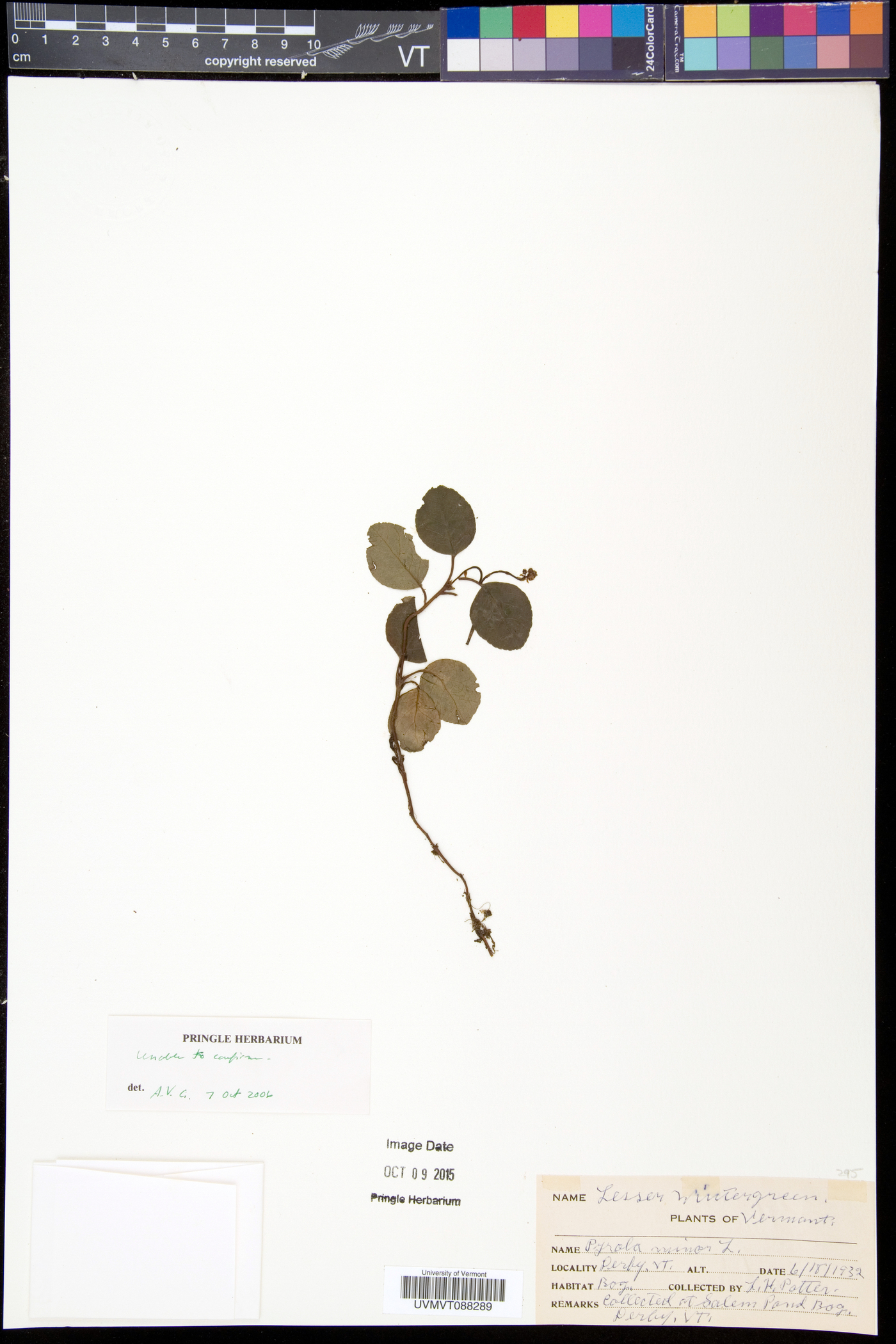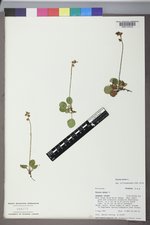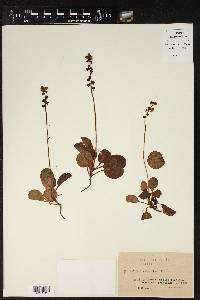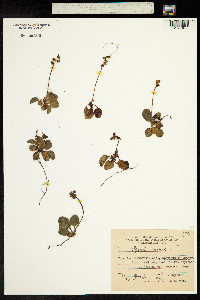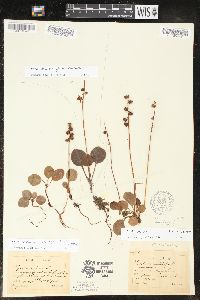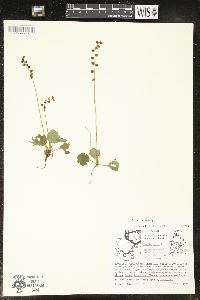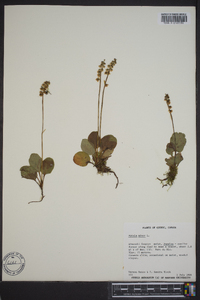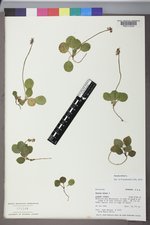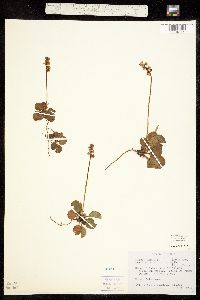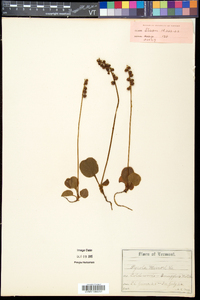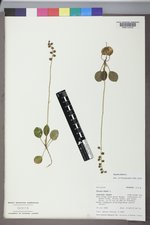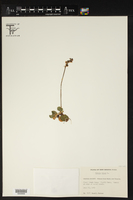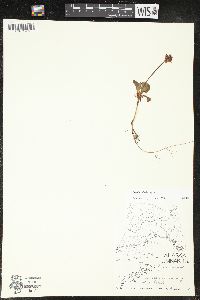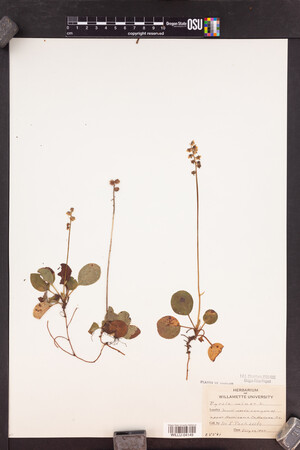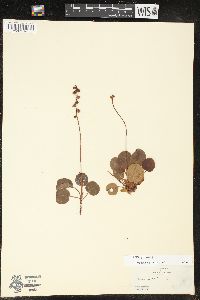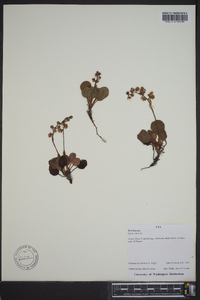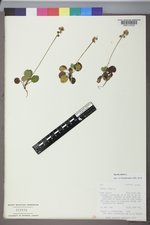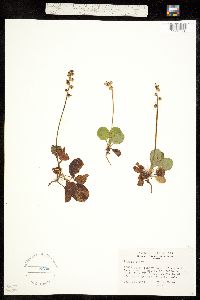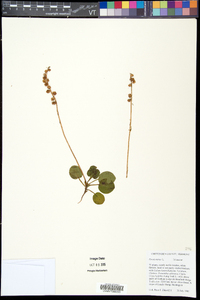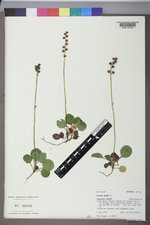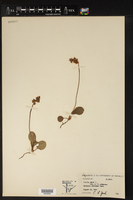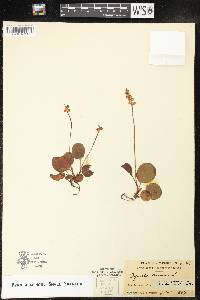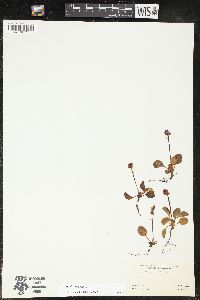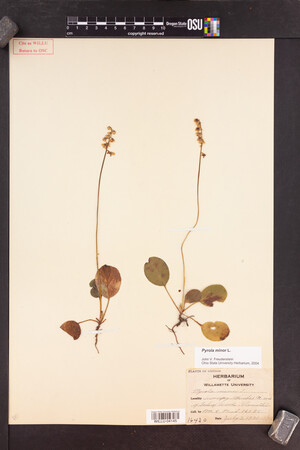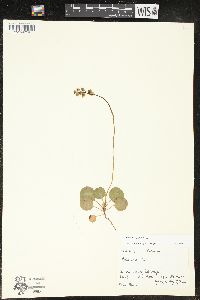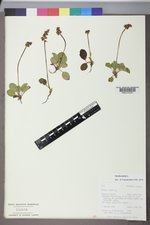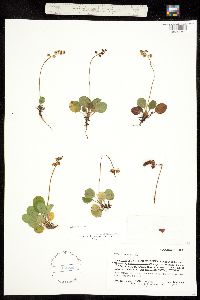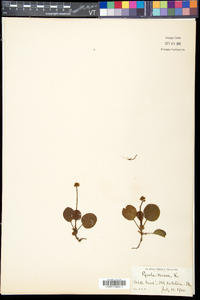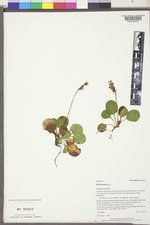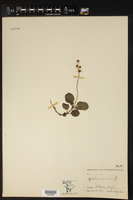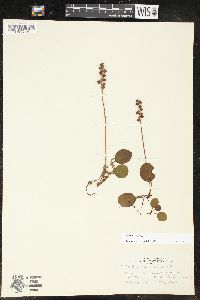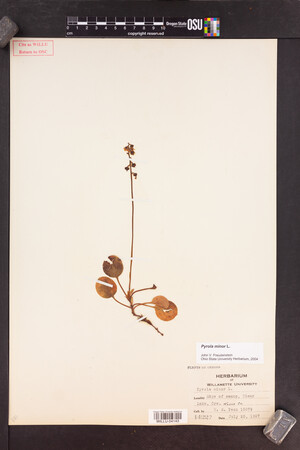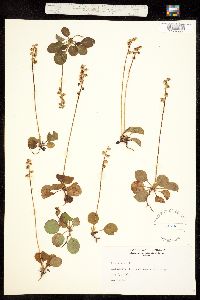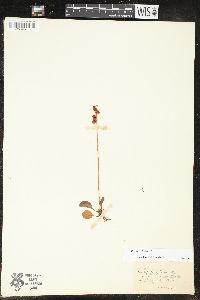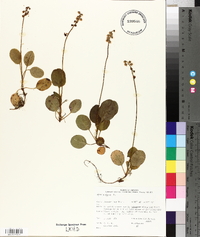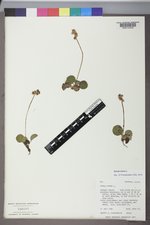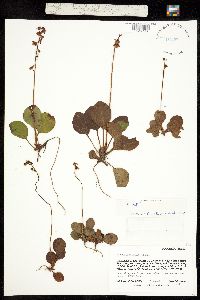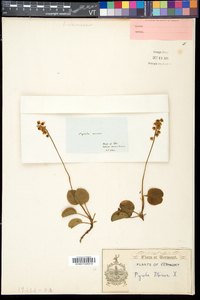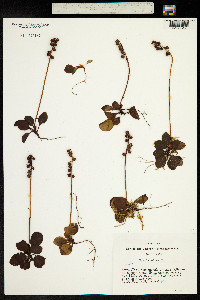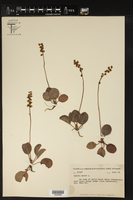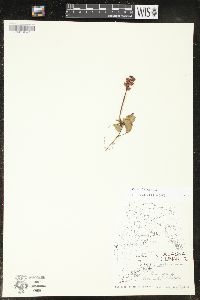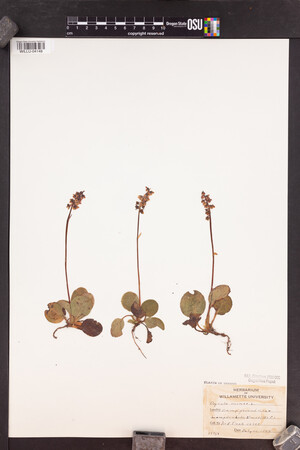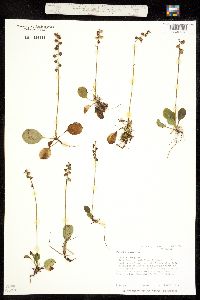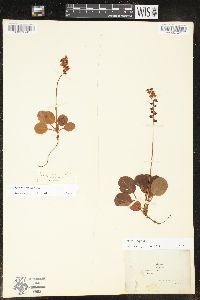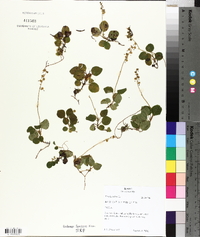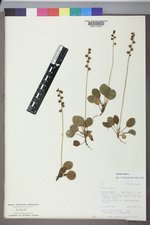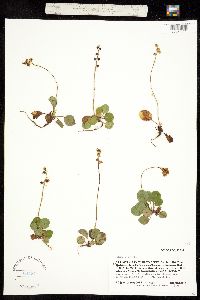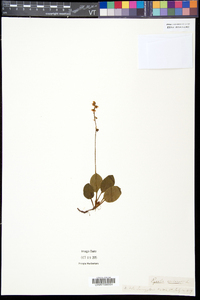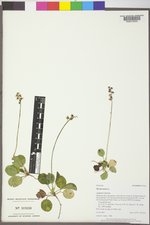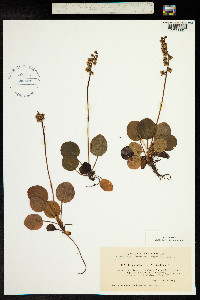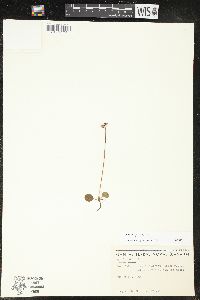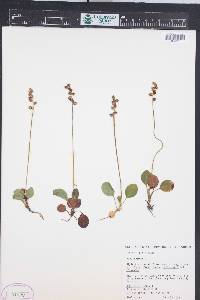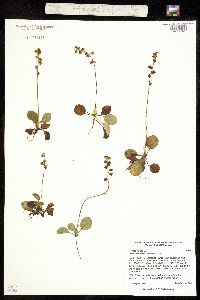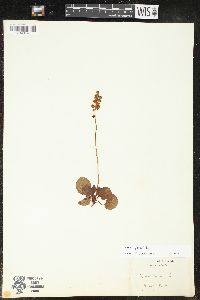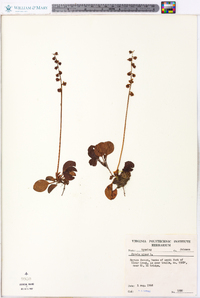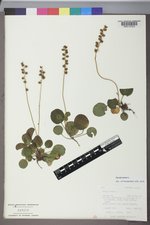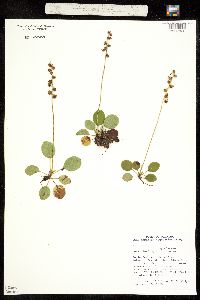Pyrola minor
|
|
|
|
Family: Ericaceae
Snowline Wintergreen, more...snowline shinleaf
[Braxilia minor (L.) House, moreBraxilia parvifolia Raf., Erxlebenia minor (L.) Rydb., Pyrola minor var. conferta (Fisch. ex Cham. & Schltdl.) A. P. Khokhrjakov, Pyrola minor var. parviflora Boivin] |
Plants rhizomatous, (0.6-)1.2-2.1(-3) dm. Leaves: petiole 2-32 mm, channeled adaxially, glabrous; blade not maculate, dull and light green abaxially, dull to shiny and green to dark green adaxially, oblong-elliptic, ovate, obovate, or round, (5-)20-30(-42) × (7-)14-27 mm, subcoriaceous, base rounded to subcordate, margins crenulate to crenulate-serrulate, apex obtuse or rounded. Inflorescences 1 per stem, 3-11(-17)-flowered; peduncular bracts absent or 1-2, lanceolate to ovate or obovate, 4-6.5 × 0.7-2 mm, chartaceous or membranous, margins entire or obscurely erose-denticulate; inflorescence bracts lanceolate to ovate-lanceolate, equaling or longer than subtended pedicels, (3-)4-5 (-7.3) × 0.5-1.4 mm, chartaceous. Pedicels 2.5-4.5 mm. Flowers radially symmetric; calyx lobes appressed or spreading in fruit, green or pink with margins hyaline to white or pinkish, deltate, 1.3-1.8 × 1.3-1.8 mm, margins entire or erose-denticulate, especially distally, apices acute to obtuse or, rarely, acuminate; petals white or pink, obovate to broadly elliptic, (3-)3.3-5 × 2.6-3.8 mm, margins entire; stamens 2.2-3.5 mm; filament base 0.1-0.4 mm wide; anthers 0.8-1.4 mm, apiculations absent or less than 0.1 mm, thecae creamy white to greenish white, often yellowish brown distally, tubules absent, pores 0.1-0.3 × 0.05-0.1 mm; ovary smooth; style included, straight, (0.5-)0.8-1.5(-1.8) mm; stigma 0.9-1.3 mm wide, lobes spreading. Capsules depressed-globose, 3-4 × 4.5-5.4 mm. 2n = 46. Flowering Jun-Aug. Moist, often mossy sites in coniferous and boreal forests, thickets, stream banks; 10-3700 m; Greenland; St. Pierre and Miquelon; Alta., B.C., Man., N.B., Nfld. and Labr., N.W.T., N.S., Nunavut, Ont., P.E.I., Que., Sask., Yukon; Alaska, Ariz., Calif., Colo., Idaho, Maine, Mich., Mont., Nev., N.H., N.Mex., N.Y., Oreg., Utah, Vt., Wash., Wis., Wyo.; Eurasia. Pyrola minor and P. asarifolia are broadly sympatric in North America. Scattered hybrids between these species have been reported, mostly from the area of sympatry (E. Haber 1984). Haber (1993) found herbarium evidence for at least one case of hybridization between P. minor and P. chlorantha. T. W. Böcher (1961) discussed hybrids between P. minor and P. grandiflora from western Greenland. The straight style and actinomorphic corolla of Pyrola minor have been interpreted as paedomorphic conditions (J. V. Freudenstein 1999b). Among three northern European species of Pyrola studied by J. T. Knudsen and J. M. Olesen (1993), the shifts in floral morphology in P. minor were found to be associated with a significantly higher capacity for self-pollination.
Plant: Perennial rhizomatous, scapose herb Leaves: blades broadly elliptic, oblong to commonly obovate, (1-)2-3(-4) cm long; petioles shorter or longer than blade INFLORESCENCE: glabrous symmetric bracteate racemes Flowers: with sepals triangular, these 1.5 mm long, the tips acute; petals white to pinkish, (2.7-)3.5-5.0(-5.4) mm long; anthers about 1 mm long, truncate without tubes, the ends of sacs open; style short, straight, included Fruit: FRUITS 5-locular drooping capsules with a depressed center and fibers connecting opened valves Misc: Moist coniferous forest; 2600-2900 m (8500-9500 ft); Jul-Aug Notes: scapes (6-)12-18 (-30) cm tall; upper scape bracts lanceolate to ovate, shorter than to somewhat exceeding pedicels, the basal scape bracts larger, ovate to oblong REFERENCES: Haber, Erich. 1992. Pyrolaceae. Ariz.-Nev. Acad. Sci. 26(1)2. Lvs elliptic or round-oblong, 2-4 cm, rounded to truncate at both ends; scape 5-15 cm, with a loose raceme of 5-15 nodding white fls; pet 5 mm; anthers very plump, 1 mm or less, broadly truncate to 2 wide terminal pores; style at anthesis ca 2 mm, about equaling the pet; 2n=46. Moist woods, circumboreal, in Amer. s. to the higher mts. of N. Engl. and n. Mich., and in the w. cordillera. (Braxilia m.; Erxlebenia m.) Gleason, Henry A. & Cronquist, Arthur J. 1991. Manual of vascular plants of northeastern United States and adjacent Canada. lxxv + 910 pp. ©The New York Botanical Garden. All rights reserved. Used by permission. |

